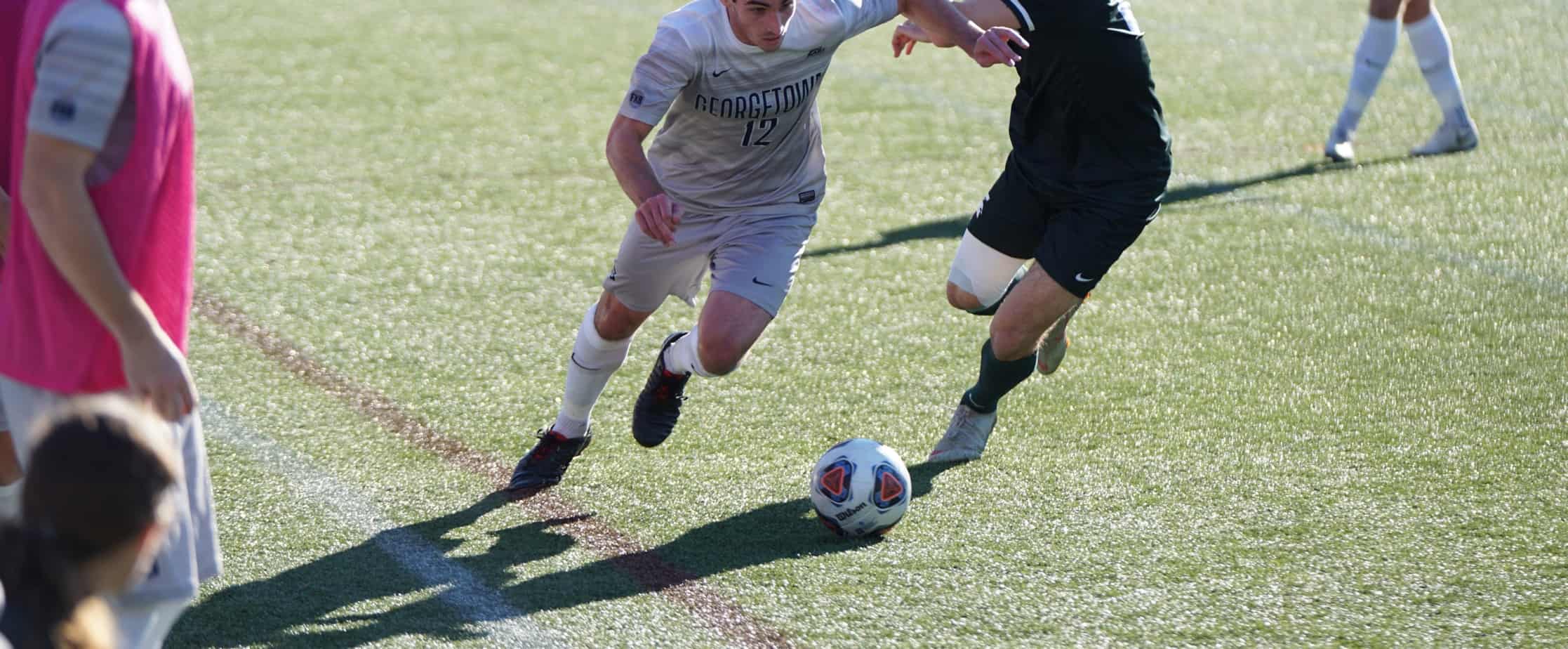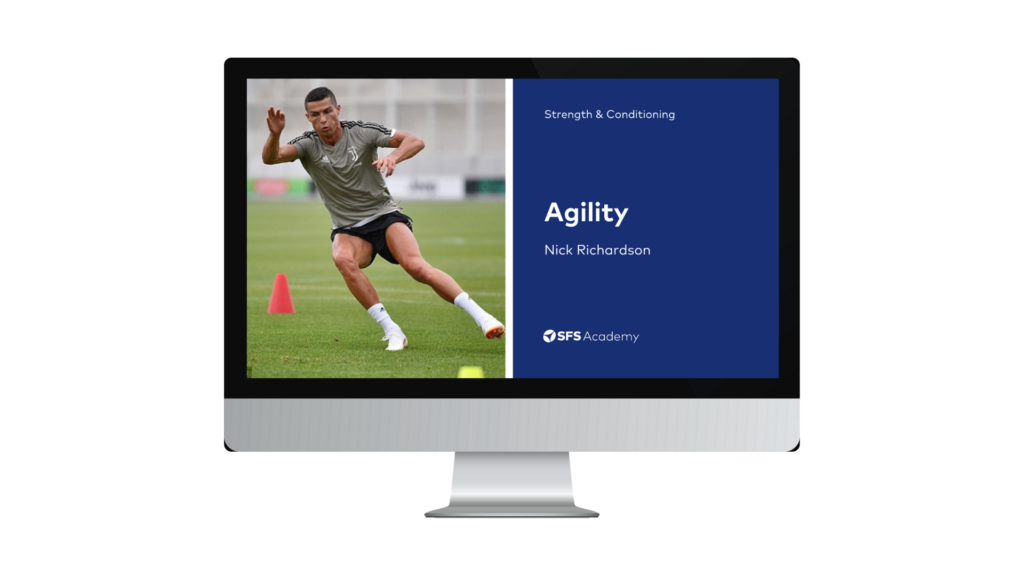Developing Field Skills in Football (Soccer) Players
How can we ensure our programming is context-driven?
- Introduction
- Needs Analysis
- Reverse Engineering
- Understanding Field Skills
- Deceleration
- Agility & Pre-planned Change of Direction Speed
- Acceleration & Speed
- Conclusion
- About the Author
- References
- Comments

Introduction
Improving the competitive performance of athletes in field-based invasion sports such as football (soccer) calls for a needs analysis of the technical/tactical (21), physiological (19) and biomechanical (18) requirements of the sport. Although soccer is an intermittent sport that uses both the anaerobic and aerobic energy systems (3), this Blog Post will focus on the biomechanical and perceptual aspects of field skills in soccer. By field skill, we refer to athletic skills such as deceleration, agility and speed.
Therefore, the aims of this Blog Post are threefold 1) discuss how we can identify and program field skills 2) clearly identify and understand the field skills and 3) describe what they look like in soccer in addition to as a general technical model.
Needs Analysis
To understand what field skills occur in soccer and how these occur, we as coaches need to develop a needs analysis which is specific to the sport (e.g. soccer) and the particular playing positions on the field (e.g. midfielder or winger).
To do this, of course, we should draw on peer-reviewed literature to provide us with evidence-based time-motion data on the demand of the sport. However, to provide more context of how things actually happen, a notational analysis of a game or video clips of gameplay on YouTube can help us figure out exactly how athletic tasks are executed and the stimulus that causes these tasks to be carried out (14).
Reverse Engineering
Once this information is collected and at our disposal, we must begin with the end in mind. S&C coaches have all been guilty of losing sight of the end outcome during the decision-making processes of exercise selection for example.
If sessions support the improvement of a field skill with specificity to how it is used in game situations, it is time well spent. This is not to say general physical preparation shouldn’t be carried out, or general speed mechanics shouldn’t be taught, but that context must be applied eventually with the aim of achieving true transfer.
Once general models of field skills such as acceleration are taught, we must continue to build field skills by ensuring that the drills prescribed are integrated by athletes in sports-specific scenarios (14) and that the gym-based exercises we prescribe support the development of these field skills. It’s also important to note that the quality and context of coaching must align with these concepts too (14).
Understanding Field Skills
Field skills in soccer can be categorised into three main groups:
- Deceleration
- Agility & pre-planned change of direction speed
- Acceleration & top speed
It’s important to note that despite being grouped, agility & pre-planned change of direction are completely independent skills (24), as are acceleration & speed (22).
As proposed by Jefferys (12, 13), skills can be broken down into:
- Initiation movements – Used to start movement or change motion (e.g. Side-step motion to move laterally whilst watching play).
- Transition movements – Used to set up a position where subsequent movement can be efficiently executed (e.g. crossover step to assume a position facing forwards).
- Actualization movements – The final movement that determines success in an athletic task (e.g. following a transition with a sprint to beat an opponent).
[optin-monster-shortcode id=”fdykgtgzdw1wjitm1pi4″]
Deceleration
Deceleration is defined as a rapid stop or decrease in the body’s velocity, followed by re-acceleration in a different direction (10). This means that deceleration is a transition movement (14).
Kinematically it can be described by a centre of mass (CoM) posterior to the feet with a full foot heel strike, small steps and a wide base with knee flexion. Kinetically it can be described by high braking forces, long ground contact times, high step frequencies and eccentric muscle actions of the quadriceps and gastrocnemius (5, 1). Gradual progression in deceleration is key as decelerations high a load that is 37 % higher than accelerations per square metre (8).
Being a transition movement which precedes change of direction (CoD) and having a higher occurrence in small-sided games (SSG) (21), sessions entirely dedicated to deceleration are likely unwarranted, especially when decelerations occur 2.9x more frequently than accelerations (8).
Agility & Pre-planned Change of Direction Speed
Sprints that include a CoD precede 6 % of all goal-scoring situations in soccer (6). Even though this may appear low, players cover an average of 217 + 165 m through multidirectional sprints (4), accounting for 3.5 % of their total distance. From a time-motion perspective, players change direction every 3.8 – 4.5 seconds (3).
However, true Change of Direction Speed (CoDS) in invasion sports is rare (12), defined as a pre-planned task where “change of direction” occurs (20). Albeit, closed CoDS drills can be used as general tissue preparation to develop eccentric strength, dynamic balance and concentric rate of force development as a physical foundation to agility without a cognitive component.
This isn’t to say that developing CoDs is useless. Pre-planned side steps result in greater lateral foot placement, greater lateral movement speed, greater forward foot displacement, increased hip abduction, lower knee joint angles and reduced forces through the knee than unplanned side stepping (11). This can help us develop the physical aspects of agility.
On the other hand, agility is defined as a “rapid whole-body movement with a change of velocity or direction in response to a stimulus”. With a change of velocity being agility, deceleration alone could be performed as an offensive agility transition (24).
For example, a winger could be performing a linear sprint with the ball down the line, towards the touchline. As they approach the touchline at a high speed, they stop the ball before it goes out, decelerate past the ball and turn back towards it to cross or pass. The aim of the deceleration was to go from ‘fast to slow’ more suddenly than a defender, to create time and space to execute a pass or cross.
Acceleration & Speed
Linear acceleration and maximum velocity sprinting are soccer-specific actions which can impact the outcome of games (16). Elite soccer players average 17 m per sprint, with ~50 % being shorter than 10 m (8) and only 4 % reaching 30 m (3).
45 % of goal-scoring scenarios are preceded by a linear sprint (6). Although forwards, wingers and full-backs perform more sprints compared to centre-backs and central midfielders, there doesn’t appear to be differences in sprint distances (7). Forwards show superior sprint speed to other positions, with defenders and midfielders showing similar sprint capabilities, followed by goalkeepers (9).
Sprinting bouts are often preceded by players already being in motion (16) and successful acceleration in team sports has been characterised by faster ground contact times and increased stride frequency (17).
Acceleration in soccer can start as an initiation movement in a variety of ways such as shuffling back, moving side on or in stationary facing backwards. This means that acceleration training must go beyond wall drills. Especially when notational analysis shows that defenders may spend much of their time sprinting with their torso and head facing play whilst their legs are forwards, sprinting back towards goal.
It’s also not uncommon for soccer players to sprint in curved lines. Attackers (centre forwards) perform larger angled curved sprints (10-15°+), to run around and in behind defenders who perform smaller angled sprints (7).
Conclusion
The main aims of this Blog Post were threefold 1) discuss how we can identify and program field skills 2) clearly identify and understand the field skills and 3) describe what they look like in soccer, rather than as a general technical model.
To conclude, S&C coaches should ensure they truly understand not only the demands of sports such as soccer and the individual positions, but how movements occur. S&C coaches must reverse engineer their programming process and work backwards from the end outcome to ensure their programming and coaching are context-driven to improve field skills and drive high on-field performance.
[optin-monster-shortcode id=”ky9hxykj6qpuqfmcbnlv”]
References
- Andrews, J.R., McLeod, W.D., Ward, T. and Howard, K. (1977). The cutting mechanism. The American journal of sports medicine, 5(3), pp.111-121.
- Bangsbo, J. (1994). Energy demands in competitive soccer. Journal of sports sciences, 12, pp.S5-12.
- Bangsbo, J. (1994b). The physiology of soccer – with special reference to intense intermittent exercise. Acta Physiologica Scandinavica, suppl. 619, 1 – 155.
- Castagna, C., D’Ottavio, S. and Abt, G. (2003). Activity profile of young soccer players during actual match play. Journal of strength and conditioning research, 17(4), pp.775-780.
- Dintiman G and Ward B. Starting and Stopping. In: Sports Speed (3rd ed)., (2003). Champaign, IL: Human Kinetics. pp. 213–217.
- Faude, O., Koch, T. and Meyer, T. (2012). Straight sprinting is the most frequent action in goal situations in professional football. Journal of sports sciences, 30(7), pp.625-631.
- Fitzpatrick, J.F., Linsley, A. and Musham, C. (2019). Running the curve: a preliminary investigation into curved sprinting during football match-play. Sport Performance & Science Reports, 55, p.v1.
- Harper, D. J., & Kiely, J. (2018). Damaging nature of decelerations: Do we adequately prepare players?. BMJ open sport & exercise medicine, 4(1) p.e000379.
- Haugen, T.A., Breitschädel, F. and Seiler, S. (2020). Sprint mechanical properties in soccer players according to playing standard, position, age and sex. Journal of Sports Sciences, pp.1-7.
- Hewit, J., Cronin, J., Button, C. and Hume, P. (2011). Understanding deceleration in sport. Strength & Conditioning Journal, 33(1), pp.47-52.
- Houck, J. R., Duncan, A., & De Haven, K. E. (2006). Comparison of frontal plane trunk kinematics and hip and knee moments during anticipated and unanticipated walking and side step cutting tasks. Gait & posture, 24(3), pp.314-322.
- Jeffreys, I. (2006). Optimising speed and agility development using target classifications and motor learning principles. Prof Strength Cond, 3, pp.11-13.
- Jeffreys, I. (2006b). Motor learning-Applications for agility, part 1. Strength and conditioning journal, 28(5), p.72.
- Jeffreys, I. (2008). Movement training for field sports: Soccer. Strength & Conditioning Journal, 30(4), pp.19-27.
- Jeffreys, I. (2011). A task-based approach to developing context-specific agility. Strength & Conditioning Journal, 33(4), pp.52-59.
- Little, T. and Williams, A. (2003). Specificity of acceleration, maximum speed and agility in professional soccer players. (pp. pp-144). Routledge: London, UK.
- Murphy AJ, Lockie RG, Coutts AJ. (2003) Kinematic determinants of early acceleration in field sport athletes. Journal of Sports Sci Med., 2(4), pp.144–150.
- Reilly, T., Bangsbo, J. and Franks, A. (2000). Anthropometric and physiological predispositions for elite soccer. Journal of sports sciences, 18(9), pp.669-683.
- Stølen, T., Chamari, K., Castagna, C., and Wisløff, U. (2005). Physiology of soccer: an update. Sports medicine (Auckland, N.Z.), 35(6), pp.501-536.
- Sheppard, J.M. and Young, W.B. (2006). Agility literature review: Classifications, training and testing. Journal of sports sciences, 24, pp.919-932.
- Turner, A.N., and Stewart, P.F. (2014). Strength and Conditioning for Soccer Players. Strength and Conditioning Journal, 36(9), pp.1-13.
- Uthoff, A., Oliver, J., Cronin, J., Harrison, C. and Winwood, P. (2018). Sprint-Specific Training in Youth: Backward Running vs. Forward Running Training on Speed and Power Measures in Adolescent Male Athletes.
- Wild, J., Bezodis, N.E., Blagrove, R. and Bezodis, I.N. (2011). A biomechanical comparison of accelerative and maximum velocity sprinting: Specific strength training considerations. Professional Strength and Conditioning, 21, pp.23-37.
- Young, W.B., Dawson, B. and Henry, G.J. (2015). Agility and change-of-direction speed are independent skills: Implications for training for agility in invasion sports. International Journal of Sports Science & Coaching, 10(1), pp.159-169.




